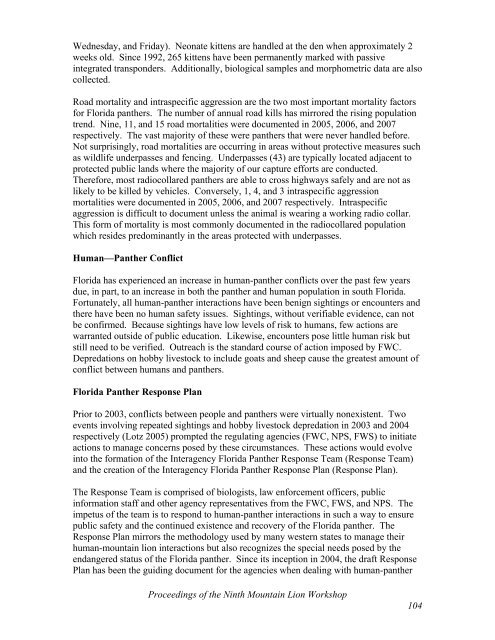Proceedings of the Ninth Mountain Lion Workshop - Carnivore ...
Proceedings of the Ninth Mountain Lion Workshop - Carnivore ...
Proceedings of the Ninth Mountain Lion Workshop - Carnivore ...
You also want an ePaper? Increase the reach of your titles
YUMPU automatically turns print PDFs into web optimized ePapers that Google loves.
Wednesday, and Friday). Neonate kittens are handled at <strong>the</strong> den when approximately 2<br />
weeks old. Since 1992, 265 kittens have been permanently marked with passive<br />
integrated transponders. Additionally, biological samples and morphometric data are also<br />
collected.<br />
Road mortality and intraspecific aggression are <strong>the</strong> two most important mortality factors<br />
for Florida pan<strong>the</strong>rs. The number <strong>of</strong> annual road kills has mirrored <strong>the</strong> rising population<br />
trend. Nine, 11, and 15 road mortalities were documented in 2005, 2006, and 2007<br />
respectively. The vast majority <strong>of</strong> <strong>the</strong>se were pan<strong>the</strong>rs that were never handled before.<br />
Not surprisingly, road mortalities are occurring in areas without protective measures such<br />
as wildlife underpasses and fencing. Underpasses (43) are typically located adjacent to<br />
protected public lands where <strong>the</strong> majority <strong>of</strong> our capture efforts are conducted.<br />
Therefore, most radiocollared pan<strong>the</strong>rs are able to cross highways safely and are not as<br />
likely to be killed by vehicles. Conversely, 1, 4, and 3 intraspecific aggression<br />
mortalities were documented in 2005, 2006, and 2007 respectively. Intraspecific<br />
aggression is difficult to document unless <strong>the</strong> animal is wearing a working radio collar.<br />
This form <strong>of</strong> mortality is most commonly documented in <strong>the</strong> radiocollared population<br />
which resides predominantly in <strong>the</strong> areas protected with underpasses.<br />
Human—Pan<strong>the</strong>r Conflict<br />
Florida has experienced an increase in human-pan<strong>the</strong>r conflicts over <strong>the</strong> past few years<br />
due, in part, to an increase in both <strong>the</strong> pan<strong>the</strong>r and human population in south Florida.<br />
Fortunately, all human-pan<strong>the</strong>r interactions have been benign sightings or encounters and<br />
<strong>the</strong>re have been no human safety issues. Sightings, without verifiable evidence, can not<br />
be confirmed. Because sightings have low levels <strong>of</strong> risk to humans, few actions are<br />
warranted outside <strong>of</strong> public education. Likewise, encounters pose little human risk but<br />
still need to be verified. Outreach is <strong>the</strong> standard course <strong>of</strong> action imposed by FWC.<br />
Depredations on hobby livestock to include goats and sheep cause <strong>the</strong> greatest amount <strong>of</strong><br />
conflict between humans and pan<strong>the</strong>rs.<br />
Florida Pan<strong>the</strong>r Response Plan<br />
Prior to 2003, conflicts between people and pan<strong>the</strong>rs were virtually nonexistent. Two<br />
events involving repeated sightings and hobby livestock depredation in 2003 and 2004<br />
respectively (Lotz 2005) prompted <strong>the</strong> regulating agencies (FWC, NPS, FWS) to initiate<br />
actions to manage concerns posed by <strong>the</strong>se circumstances. These actions would evolve<br />
into <strong>the</strong> formation <strong>of</strong> <strong>the</strong> Interagency Florida Pan<strong>the</strong>r Response Team (Response Team)<br />
and <strong>the</strong> creation <strong>of</strong> <strong>the</strong> Interagency Florida Pan<strong>the</strong>r Response Plan (Response Plan).<br />
The Response Team is comprised <strong>of</strong> biologists, law enforcement <strong>of</strong>ficers, public<br />
information staff and o<strong>the</strong>r agency representatives from <strong>the</strong> FWC, FWS, and NPS. The<br />
impetus <strong>of</strong> <strong>the</strong> team is to respond to human-pan<strong>the</strong>r interactions in such a way to ensure<br />
public safety and <strong>the</strong> continued existence and recovery <strong>of</strong> <strong>the</strong> Florida pan<strong>the</strong>r. The<br />
Response Plan mirrors <strong>the</strong> methodology used by many western states to manage <strong>the</strong>ir<br />
human-mountain lion interactions but also recognizes <strong>the</strong> special needs posed by <strong>the</strong><br />
endangered status <strong>of</strong> <strong>the</strong> Florida pan<strong>the</strong>r. Since its inception in 2004, <strong>the</strong> draft Response<br />
Plan has been <strong>the</strong> guiding document for <strong>the</strong> agencies when dealing with human-pan<strong>the</strong>r<br />
<strong>Proceedings</strong> <strong>of</strong> <strong>the</strong> <strong>Ninth</strong> <strong>Mountain</strong> <strong>Lion</strong> <strong>Workshop</strong><br />
104
















